Revised 23 April 2022
Accepted 18 October 2022
Available Online 21 November 2022
- DOI
- https://doi.org/10.55060/s.atssh.221107.020
- Keywords
- Ming Dynasty
Lacquer craftsmanship
Style evolution - Abstract
As early as the Neolithic Age, lacquer was recognized by the ancients and used to make lacquerware. With the continuous development of lacquer craftsmanship, to the Ming Dynasty, the craftsmanship of lacquerware has reached its peak, which is the golden age of the development of lacquerware in Chinese history. Many outstanding and representative lacquerware works have appeared, and many Chinese and foreign scholars have done in-depth research on the lacquerware in this period. The author will take the lacquerware in different periods of the Ming Dynasty as the starting point to explore the evolution of the styles and styles of lacquerware in the Ming Dynasty.
- Copyright
- © 2022 The Authors. Published by Athena International Publishing B.V.
- Open Access
- This is an open access article distributed under the CC BY-NC 4.0 license (https://creativecommons.org/licenses/by-nc/4.0/).
1. INTRODUCTION
The Ming Dynasty was an important period in the history of the development of Chinese lacquerware. The art of lacquerware has achieved brilliant achievements in the rule of the Ming Dynasty for more than 270 years. With the progress of social economy, politics, culture and other fields, the development of lacquerware can be roughly divided into three stages: early period (Hongwu to Xuande: 1368-1435), middle period (Zhengtong to Zhengde: 1436-1521), late period (Jiajing to Chongzhen: 1522-1644). The art styles of lacquerware in these three periods were different and featured prominently. The court lacquer art and the folk lacquer art developed side by side, and both achieved brilliant achievements.
The well-known lacquer artwork “Xiu Shi Lu”, which was born in the Longqing period of the Ming Dynasty (1567-1572), mainly classified lacquerware according to techniques. According to the records and the analysis and research of the remains, the Ming Dynasty lacquerware can be divided into: carved lacquer, filled lacquer, smooth lacquer, colorful-painted lacquer (including oil painting), painted gold paint, war-cut lacquer, gold lacquer, piled lacquer, inlayed lacquer, color lacquerware and other categories. These lacquerwares are used in all aspects of life, and the remaining works are mostly plates and boxes of different styles, including pots, plates, bottles, furnaces, study utensils, and Buddha offerings. Flowers, fish and insects, songbirds, flying phoenixes, cloud dragons, pans, exotic animals, landscape characters, historical stories, myths and legends, as well as patterns implying auspiciousness and longevity are common in pattern decoration. Such a variety of lacquerware varieties, varied shapes and themes, and skilled and superb manufacturing techniques show the prosperity of lacquerware arts and crafts in the Ming Dynasty ([1], p.3).
2. STYLE AND PATTERN OF LACQUERWARE IN THE EARLY MING DYNASTY
For about 50 years, from 1368 when Zhu Yuanzhang established the Ming Dynasty regime to the 18th year of Yongle (1420) when the capital moved to Beijing, production of lacquerware in the early Ming Dynasty had begun to take shape, and production technology of lacquerware was mainly inherited from the Song and Yuan traditions and further developed. After the capital was moved to Beijing during Yongle period in the Ming Dynasty, in order to meet the needs of the royal family, the imperial supervisor established an orchard factory in the imperial city, which was especially responsible for manufacturing lacquerware for the royal family, and ordered the famous lacquer maker at that time to preside over the production, and produced a large number of lacquer-filled gold lacquerware and carved lacquer lacquerware. At the same time, folk lacquer artists also began to imitate the palace lacquerware, and they made carved lacquer and lacquer products one after another. At the same time, in addition to the official orchard factory, folk lacquer workshops in Southwest China, Fujian, Zhejiang and Anhui are also prosperous, producing more than 100 kinds of lacquerware ([2], p.33).
The lacquerware of the early Ming Dynasty inherited the shape and decoration characteristics of the lacquerware of the Song and Yuan Dynasties. During the Yongle period of the Ming Dynasty, lacquerware products were mainly plates and boxes, and also included bowls, cup holders, bottles, vials, and step stools. There were few changes in the shape of the vessel; the decorative patterns were mostly dragons and phoenixes, flowers, landscapes, etc. For works on the theme of dragon and phoenix, the decorative patterns are mostly engraved on the heart of the plate or the lid of the sugarcane segment box, which was generally the image of a side dragon, with a vigorous shape, full of vitality, and a vivid demeanor. The utensils with the theme of flowers were mostly large flowers with lush branches and small buds that were evenly decorated around them. This feature is more prominent in carved lacquer works. Most of the carved lacquer products were not treated with brocade, but with yellow lacquer as the ground color. This kind of treatment can not only make the theme of the work more vivid, but also can be used as a sign of the depth of knife carving. Landscape-themed works generally used different forms of brocade patterns to express different natural spaces. The sky is depicted with tortuous single lines; the smooth and rhythmic brocade patterns are transformed into water patterns; the dignified and upright squares and slanted squares represent the land. The combination of these three different brocade patterns shows an extremely profound space. On the inner edge of the bottom, the inscription “Made in Great Ming Yongle Year” is vertically engraved with a needle inscription, with delicate fonts and slender strokes. At the bottom of the carved lacquer, there is a clear year number inscription, starting with Ming Yongle (Fig. 1).
The “Red Double Peony Pattern Plate” (Fig. 2) collected by the Forbidden City, Beijing, was made during the Yongle period, with a height of 4.1 cm and a diameter of 32.5 cm. It is one of the typical types of the Yongle period and is a large lacquer plate ([3], p.20). The composition of the work is a typical Ming Yongle lacquer carving style, with double-layer flowers carved on the inside of the plate, peony patterns on the outer edge, and yellow lacquer at the bottom of the pattern. The upper pattern of the pattern of plate center is a blooming half-side peony in the center, surrounded by four smaller peonies with the same half-side, with branches, leaves and flower buds of different sizes in between; the branching position of the lower pattern is completely opposite to that of the upper pattern. The composition of the whole work is full, the delineation is meticulous, the knife technique is skillful and powerful, and the polishing of the edge of the pattern is very smooth, and there is almost no trace of knife engraving.
In the Xuande period, Lacquerware products appeared in the lacquerware with pick-color and gold-colored lacquer. The shapes of the works were varied, the decorative themes were not much different from those in the Yongle period, and the technique of “leaving space” appeared in the pattern processing. The style processing method was completely different from the Yongle period. It changed the Ming Yongle needle mark to the Ming Xuande regular script inlaid gold inscription, and the Ming Xuande knife engraved and inlaid gold inscription became a model for the recognition of Ming lacquerware. In a word, the production of lacquerware in the early Ming Dynasty developed leaps and bounds on the basis of inheriting the traditions of Song and Yuan Dynasty ([1], p.5).
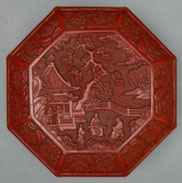
Yongle period (Ming Dynasty): Bafang Box with pick-red playing-qin figure. Collection: Palace Museum.
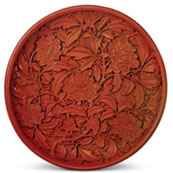
Yongle period (Ming Dynasty): pick-red double layer peony pattern plate. Collection: Palace Museum.
3. STYLE AND PATTERN OF LACQUERWARE IN THE MID-MING DYNASTY
After the Xuande period in the Ming Dynasty, the development of lacquer craftsmanship was affected by the social and economic recession, and the official lacquerware workshop came to a standstill for a time, with very few works left. The varieties of lacquerware in this period included pick-red, pick-black, pick-color and gold lacquer, and local lacquerware made in Yunnan and Gansu was more prominent.
From the handed down works, it can be seen that the decorative pattern style of lacquerware has changed from simple and generous to slim and delicate. The shape was changeable, which increased significantly compared to the early Ming Dynasty. Decorative patterns were more colorful. Lacquerware products with the theme of flowers have changed a lot, and the themes of broken branches, flowers and birds have been added. The large flowers of the early Ming Dynasty were greatly reduced and replaced by small and exquisite flowers and broken branches, such as begonia, apricot, peach and so on. Most of the carved lacquer works used vermilion lacquer as the ground to engrave brocade patterns, and black lacquer as the surface to engrave flowers. Many works use the technique of leaving space to integrate decorative elements such as flowers, birds, fish and insects into the overall pattern, which is refreshing. In terms of knife technique, it is not as round and smooth as the previous works, but slightly sharp.
The Round Box with Pick-red Pine, Bamboo, Plum, Grass and Insect Patterns (Fig. 3) was made in the mid-Ming Dynasty and is now in the Palace Museum. It is 9.2cm high and 27cm in diameter. The body of the box is round, the cover is carved with pine, bamboo, plum and rocks, and bees, butterflies, mantises, frogs and lizards are dotted in a large area. Plants and animals have different postures and the depiction is very dense and compact, presenting a strong natural atmosphere. The cover and side are engraved with tangled lotus and eight-treasure patterns, and the edge of the mouth is engraved with slanted floral brocade patterns, which are consistent with the pattern on the cover. This box has a unique style, full and complex composition, exquisite and meticulous knife work, not sharpened after engraving, and all sharp edges maintained. It is a typical representative of red lacquerware in the mid-Ming Dynasty.
At this time, with the stagnation of the official lacquer workshops in the palace, folk lacquer art quietly emerged, and Yunnan carved lacquer is a very representative branch. When discussing carved lacquer products in “Wanli Ye Huo Bian” of Ming Dynasty, it pointed out: “Today's carved lacquer and other objects, the most important is Song tick, followed by Yongle and Xuande orchard factories of this dynasty, whose price is almost the same as that of Song. There is lacquer light and dark, and the carvings are clumsy, which are called ‘old Yunnan’” ([4], p.265). Yunnan carved lacquer products generally have thin lacquer, dark color and slightly astringent lacquer quality. This type of lacquerware is usually called “cloud carving”, which is the “Yunnan Craft” product recorded in literature. The themes of these works are mostly based on scenes in nature, such as flowers, fish and insects, birds, beasts, as well as the auspicious ganoderma lucidum, pan-length and the unicorn in myths and legends. Decorations depicted are very vivid, depicting the creatures in nature so vividly that the viewer seems to be in it when viewing it, which is very interesting. These excellent lacquer carvings with strong local colors in these places show the strong creativity and vitality of folk crafts, which are unmatched by palace workshops.
As for the history of lacquer craftsmanship in Gansu, there are few historical records, and little is known. In recent years, according to the introduction of Tianshui Carved Lacquer Craft Factory, the lacquer craft of Tianshui, Gansu was introduced from Shaanxi and Sichuan in the early 20th century. At that time, the guardian envoy of Longnan and Daoyin of Tianshui learned from a Xi'an Luqing lacquer craftsman, and founded “Gansu Longnan No. 1 Craft Factory”, which has a lacquer craft department, mainly producing carved and filled lacquer furniture, edible utensils, storage boxes, inkstone boxes, walking sticks, etc. ([1], p.7). According to several handed down cultural relics, Tianshui lacquerware has a superb manufacturing process, meticulous carving techniques, different figures, slender shapes and unique styles.
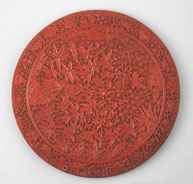
Middle Ming Dynasty: round box with pick-red pine, bamboo, plum, grass and insect patterns. Collection: Palace Museum.
All in all, the lacquer craftsmanship in the middle Ming Dynasty was affected by economic, political and other factors. Production of lacquerware in the palace and officials showed signs of decline, and the number of handed down works dropped sharply, but a small number of fine works can still be seen, especially the development of folk lacquer craftsmanship. In particular, development of folk lacquer craftsmanship has made up for the blank of official lacquerware to a certain extent, and injected new blood into the development of lacquer craftsmanship.
4. STYLE AND PATTERN OF LACQUERWARE IN THE LATE MING DYNASTY
In the late Ming Dynasty, after hundred years of precipitation, lacquer craftsmanship changed from the simple, generous, dignified and rich in the early Ming Dynasty to a new style of luxurious and exquisite craftsmanship. The production volume of carved and filled lacquerware and gold-drawing lacquerware in the lacquer craft of the imperial palace increased sharply, coupled with the increasingly convenient transportation, rapid development of the commodity economy, and the expansion of the lacquerware production area, some new varieties have sprung up like mushrooms after the rain, and the folk lacquer craftsmanship has also made a qualitative leap, and the lacquerware industry has shown a thriving scene.
The lacquer carvings of Jiajing and Wanli periods generally tended to organize a variety of dense and diverse contents on one utensil, natural scenes appear within the consecration, and some objects are highly patterned according to the needs of the powder structure. In terms of technique, some high-quality knives are carried like a pen, showing the beauty of sharp edges. This technique continued until the Qing Dynasty ([5], p.93–94). The subject matter was very different from the previous period. There were a few natural scenes that inherit the traditions of the previous dynasties, and most of them were themes with auspicious meanings. The pick-color Fu Lu Shou three-peach-patterned disc of the Jiajing period (Fig. 4) is painted in pick-color red, green, and yellow as a whole. The inside of the plate is engraved with a yellow square swastika pattern of brocade, and then the pick-red ganoderma pattern is engraved. There are three peaches in the center. The three peaches are all hooked with cloud patterns as brocade. The three characters “Fu”, “Lu” and “Shou” are engraved with seal script on it., the side of the plate is engraved with the pattern of double dragons circling ganoderma lucidum, and the outer wall of the plate is engraved with flower patterns such as chrysanthemum, lotus, peach and so on. In the center is a vertical line inscribed with a knife inscribed in gold regular script “Made in Great Ming Jiajing Year”. This disc is ingeniously conceived, very innovative in its conception, full of composition, delicate in delineation, extremely auspicious, and its decorative style is unique to the Jiaqing period.
There were many kinds of gold-painted products in this period, which are very exquisite, such as furniture, screens, bookcases, desks, etc. At this time, the gold-painted lacquerware mostly used black lacquer as the ground, and also used vermilion lacquer as the ground, and painted various patterns on the lacquer surface, with delicate painting skills and distinct layers; while maintaining the traditional manufacturing method, the lacquer filling and gold lacquerware had been greatly improved in manufacturing technology, with richer filling colors and more exquisite carvings. In addition to traditional furniture and tray boxes, silver ingot-style, Begonia-style, Fangsheng-style, and plum-blossom-style had also appeared. The lacquer works during the Wanli period include lacquer-filled double dragon oval boxes and city lacquer double-phoenix rectangular boxes. The style of the works is magnificent and has high artistic achievements (Fig. 5).
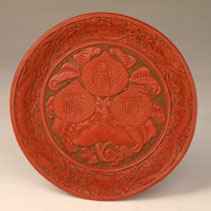
Jiajing period (Ming Dynasty): pick-color Fu Lu Shou 3-peach-patterned disc. Collection: Palace Museum.
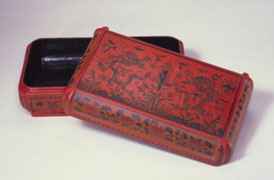
Wanli period (Ming Dynasty): rectangular box with double dragon pattern filled with color and lacquer. Collection: Palace Museum.
At this time, with the development of the commodity economy, in addition to the court, the demand for lacquerware among the people also increased significantly, the production range of lacquerware was further expanded, and some lacquerware products with local characteristics appeared. Wood-carved colored lacquerware was once popular in Shaanxi and Shanxi regions. This method of making lacquerware is to engrave patterns on the wooden body, and then fill the inside with lacquer. The colors to be filled were generally thicker paint colors such as red, blue, white, and black, and both gold and silver were used for decoration; in some works, patterns are piled up with lacquer ash on the tread, and after a certain height, they were covered with colored lacquer to form an effect similar to relief. This type of lacquerware was commonly used in the manufacture of furniture and furnishings such as screens, hanging screens, and interstitial screens. The motifs were mostly historical stories, landscape figures, flowers, birds, fish and insects, etc. These works have smooth lines, powerful knives, clear contrasts, and very distinctive artistic features. In addition, Putian, Fujian, Chaozhou, Guangdong and other regions are known for their woodcarving gold lacquer works, which are famous across the world. The themes were mostly dramatic figures, historical stories, etc. The technique was to carve on the surface of the wooden tire, and then paste gold or mud gold, showing a brilliant and dazzling artistic effect. In the late Ming Dynasty, Ji'an, Jiangxi Province, was a typical traditional production area of lacquerware inlaid with snails. Most of the lacquerware were made of black lacquer. Clam shells, abalone shells, etc. needed to be chiseled into dozens of neat and regular specifications with tools, and inlaid on the primer according to the pattern. The works are fine, dense and ingenious, and some inlaid luodian products are also inlaid with gold pieces or gold threads. The overall effect is splendid, rich and colorful. After the Wanli Dynasty, the Ming Dynasty fell into a chaotic situation of internal and external aggression, political turmoil, and social and economic recession. Development of lacquer craftsmanship fell into a trough. Until more than 20 years before the fall of the Ming Dynasty, there was no new development in the production of lacquer technology.
5. CONCLUSION
The brilliant achievements of lacquerware in the Ming Dynasty provided a precious material and cultural basis for the current study of ancient lacquer art and also provided a lot of inspiration for the creation of current lacquer artists. Ancient books, cultural relics, etc. that were handed down from ancient times to the present are the source of creation by contemporary artists. While inheriting the excellent culture of the predecessors, later generations created batches of excellent new works by integrating the characteristics of the times, continuing the life of lacquer art.
REFERENCES
Cite This Article

TY - CONF AU - Chi Zhang PY - 2022 DA - 2022/11/21 TI - Style Evolution of Lacquerware in the Ming Dynasty BT - Proceedings of the 8th International Conference on Arts, Design and Contemporary Education (ICADCE 2022) PB - Athena Publishing SP - 111 EP - 115 SN - 2949-8937 UR - https://doi.org/10.55060/s.atssh.221107.020 DO - https://doi.org/10.55060/s.atssh.221107.020 ID - Zhang2022 ER -









